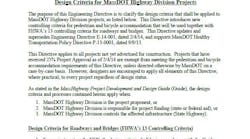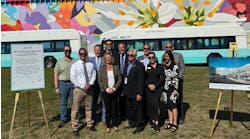Cities utilize a variety of provisions to encourage complete street development in their communities.
Indianapolis, Ind.
Anna M. Gremling
Executive Director
Indianapolis Metropolitan Planning Organization
The Indianapolis Metropolitan Planning Organization (IMPO) has long been a supporter of allowing people choice in their transportation options by encouraging the construction of multi-modal facilities. The Cultural Trail, an internationally acclaimed cycling and pedestrian facility along streets in downtown Indianapolis, is only one example of that support. It was funded in part by a federal TIGER 2009 grant as well as 2005 and 2008 Group 1 Surface Transportation Plan funding awarded by the IMPO. The Cultural Trail officially opened in 2013 and has so far generated over $300 million of new development, a number which continues to grow.
In addition, the IMPO adopted a Complete Streets Policy (CSP) in March of 2014 for the region. Though the IMPO was funding projects that were accommodating multiple modes of transportation prior to that date, there was no official policy in place. The CSP is intended to ensure that streets are designed, built, operated and maintained to be safe and accessible for everyone, regardless of whether they travel by bus, bike, foot or personal vehicle. Our region understands that building complete streets provides many benefits to residents, business owners, developers, and the community as a whole. By embracing the complete streets concept the region, the IMPO is helping to create balanced transportation systems by providing accessible, safe, and efficient connections between destinations.
The IMPO’s CSP makes it a requirement that projects selected for federal funding include complete streets elements. This moves multi-modal facilities from being accessory of road projects to being equal in terms of their transportation value and benefit to the overall health, access, and potential to generate economic opportunity within the community. In 2014, the IMPO’s CSP was ranked as the fourth-highest regional policy by Smart Growth America.
Beyond that, the IMPO encourages all of its community members to integrate sidewalks, bike facilities, transit amenities, and safe crossings into the initial design of projects, even those that aren’t proposed to the IMPO, to spare the expense and complications of retrofits implemented at a later date.
The IMPO plans to continue to provide tools, resources, and guidance for municipalities, and continue making improvements to our region.
Las Vegas, Nev.
Tina Quigley
General Manager
Regional Transportation Commission of Southern Nevada (RTC)
In the 1990s and early 2000s, Southern Nevada witnessed record-breaking population and economic growth resulting in the rapid development of sprawling communities that did not incorporate multimodal transportation street designs. These communities have become burdened with increased traffic congestion, neighborhood speeding, and indirect biking and walking routes. To directly address the need for increased connectivity and roadway safety, the RTC began to implement Complete Streets design elements in its roadway projects several years ago.
As the transit authority, transportation planning and regional traffic management agency for Southern Nevada, the RTC’s transportation projects are collaborative efforts. To determine how best to implement a Complete Streets project, the RTC works with all local jurisdictions, including the cities of Las Vegas, Henderson, North Las Vegas, Mesquite, Boulder City, and Clark County, as well as the Nevada Department of Transportation. Other stakeholders include the Southern Nevada Health District, Clark County School District and the University of Nevada, Las Vegas – Safe Community Partnership. Collectively, the RTC and appropriate entities work to identify design elements and changes that work best for each roadway project, thereby crafting and implementing a Complete Streets policy that best meets the needs of each individual community and its traffic patterns.
The RTC also serves as the administrator of Southern Nevada Strong, the first federally recognized regional plan that serves as a blueprint to plan, build and invest in complete communities. To create this regional plan, nearly 70,000 Southern Nevadans were engaged through a public outreach process for their input. Among its many findings, the plan highlights the fact that residents want improved access to quality education, affordable housing, employment opportunities, and viable transportation choices. The RTC is now working to coordinate efforts with its community partners, provide technical guidance and develop new resources to implement the goals and priorities of the Southern Nevada Strong plan, including its call for complete communities – beginning with Complete Streets.
As an example, work began this year on a joint RTC/city of Las Vegas road project to convert two busy roads in downtown Las Vegas into one-way couplets. The refurbished roads will allow for better traffic flow for all users, including cyclists, transit riders, pedestrians and automobile drivers. In addition to these types of roadway rehabilitation efforts, the RTC is leading the effort to incorporate Complete Street designs into the new community developments that are now underway.
After approving a Complete Streets study and policy in 2012, the RTC adopted its Design Guidelines for Livable Communities in 2013. The RTC and its community partners believe that Complete Street designs will continue to be the model for all future new and refurbished roadway projects throughout Southern Nevada.
Austin, Texas
Katherine Gregor
Complete Streets Program Manager
Austin Transportation Department
Are Complete Streets weird? Perhaps by auto-centric standards – which make them a great fit for Austin, Texas, where the community’s rallying cry is “Keep Austin Weird.”
Austin passed a Complete Streets Policy in June 2014 with this core intent: “The City of Austin commits to design, operate and maintain the community’s streets and right-of-way so as to promote safe, comfortable and convenient access and travel for people of all ages and abilities.”
To ensure that it gets implemented, for the past year Austin Transportation Department and our partners have been building a Complete Streets Program. Embracing a high-level policy, in some ways, was the easy part. (Ours was aggressive, includes “green streets” and urban design as well as multimodal mobility policy, was adopted unanimously by City Council, and was recognized by the National Complete Streets Coalition as a Best Policy of 2014 in the U.S.). The harder part: Aligning all efforts of all agencies and programs to implement a complete streets approach.
Fortunately, the City of Austin has been building a strong Bicycle Program since 2002. For example, between 2008 and 2013, we added a prodigious 175 miles of bicycle facilities – mostly by restriping to right-size roads and add bike lanes during routine road work. This experience retrofitting streets to add bicycle facilities has provided an excellent foundation for our Complete Streets Program. Data collected on those projects shows that they benefitted vehicular traffic too, in most cases. (See Redesigning the Street: A Report on Right-Sizing Projects in Austin.)
In 2014, a number of longer-term efforts and new Complete Streets Program initiatives came to fruition that helped us advance the new Complete Streets Policy, including a new Bicycle Master Plan and Urban Trails Master Plan. For transit, we gained valuable new experience in retrofitting two major Downtown streets to create Transit Priority Lanes to help our transit agency, Capital Metro, launch two new high-capacity MetroRapid bus routes.
Austin has been steadily implementing all aspects of the Policy. This includes advancing numerous infrastructure projects through our Active Transportation Program (with Public Works) to add new bicycle facilities and sidewalks,. Other key initiatives include: Streets for people and placemaking, city project reviews for complete street compliance, development review, transit-supportive streets, and green streets.
In 2015, the Mayor’s Challenge for Safer People and Safer Streets will provide an organizing framework for a variety of City of Austin efforts for safe and complete streets. A major focal point will be hosting the NACTO Designing Cities 2015 Conference, Oct. 28-31. This major national event for transportation professionals from leading cities across the U.S. is organized by the National Association of City Transportation Officials. To ensure that Austin fully benefits from the experts coming to town, we are organizing a concurrent Better Streets Week, offering free community talks by conference speakers, with a variety of community groups hosting events.
Boston, Mass.
Luciano Rabito, P.E.
Complete Streets Engineer
Massachusetts Department of Transportation (MassDOT)
Massachusetts has long recognized the importance of Complete Streets (CS) in our planning and design process. Legislation was enacted in 1996 calling for all reasonable provisions to accommodate bicyclist and pedestrian traffic in the planning, design, construction, reconstruction, and/or maintenance of any project undertaken by MassDOT.
MassDOT provided another strong mandate for incorporating CS into policies and practices with the award-winning 2006 Project Development & Design Guide. Its Introduction clearly states: “Transportation and the quality of life in our communities are inextricably linked. This connection is largely influenced by the role that highways, streets and sidewalks play in our lives.” The Guide details how to achieve context-sensitive design in multiple settings, including rural, suburban and urban, and accommodate all users safely and comfortably by building from the “outside in” (right of way) instead of the “inside out” (center line). A number of organizations and agencies, including the Federal Highway Administration (FHWA), have lauded the Guide.
To bolster the Guide’s impact, MassDOT offered a series of CS workshops Commonwealth-wide. Introductory and advanced trainings were offered to attract and instruct local, regional and state officials, as well as planners and designers with an interest in and responsibility for CS. Classroom and on-site instruction were provided drawing upon CS local examples.
To further ensure and promote CS, MassDOT established the Healthy Transportation Policy Directive (HTPD) in September 2013. This directive both challenged and encouraged MassDOT, our municipalities, and the design community to do more for bicyclists and pedestrians. All MassDOT projects are now rigorously reviewed to ensure that they include safe, compliant and continuous bicyclist and pedestrian accommodations, except where their travel is expressly prohibited by law. Any exemptions require sign-off from our Secretary and Chief Engineer for those projects that do not meet bicyclist and pedestrian accommodations consistent with the HTPD.
The 2014 Transportation Bond Bill created a new CS Eligibility Program, to encourage localities to adopt CS policies and to seek CS funding for local roads. MassDOT is currently developing the guidance to enable localities to apply for CS project funds; local preparations to access these CS funds are gaining momentum.
To support this process, MassDOT is preparing a new round of CS training, offering both short and long training sessions. The longer, six-hour workshops will delve more deeply into CS design and state-of-the-practice, as well as the CS funding requirements for localities seeking to access these new resources.
It is anticipated that the CS guidance and the workshops will be ready this autumn. MassDOT personnel are attending a number of seminars and trainings to assist our municipal partners with these CS opportunities. MassDOT will also focus on its exemplary CS leadership at our annual statewide Moving Together (MT15) Healthy Transportation conference, where CS policies, programs and practices will be featured at panel discussions and site visits.
Moving forward, MassDOT will be introducing its innovative Separated Bike Lane Design Guide this autumn as well as developing Road Diet design guidance through an FHWA Innovation Grant.
Lincoln, Neb.
David R. Cary, AICP
Long Range Planning Manager/Acting Director
Lincoln/Lancaster County Planning Department
Lincoln has spent many years building relationships within and between multiple departments and agencies involved in decision making and implementation efforts related to the street system. A longstanding policy from the community’s Long Range Transportation Plan (LRTP) and Comprehensive Plan is the concept of developing a multi-modal transportation system in which all modes of travel are well-served. Our recent local Complete Street policy is a natural outgrowth of this longstanding interdepartmental cooperation and policy guidance.
In September 2013, an Executive Order was signed that established a Complete Streets policy. This Executive Order was signed by not only the Mayor of Lincoln, Chris Beutler, but also by the Department Heads of Public Works & Utilities (within which our local transit agency, Star Tran, is housed), Urban Development, Planning, Parks & Recreation, Health, and Building & Safety. The Planning Department is the organizational lead for this effort that establishes a process in which Complete Streets ideals are implemented in a cost effective manner. An annual report is required as part of this policy in order to deliver information on the progress gained in this endeavor, and regular meetings are held on at least a monthly basis with the participating departments. It is important to note that the efforts of the Complete Streets policy and committee is to help develop a transportation system in Lincoln that meets the needs of all users. This does not mean that every street in Lincoln includes formal facilities for every type of user, but instead the transportation system as a whole is planned and implemented such that all users can safely and effectively move within and throughout the city.
Regular meetings of the Complete Streets Committee involve discussion on current project implementation, future project design, identification of Complete Streets gaps in the transportation system, potential ordinance changes, and transportation planning topics in general within the context of Complete Streets. In addition to the Departments that were signatories to the Complete Streets Executive Order as identified above, we often have the Law Department, the Lincoln Police Department, our Parking Program Manager, and other guests attend depending on the particular topic at hand.
Our experience thus far with the local Complete Streets policy and committee has been very positive. Each member of the committee understands the purpose of the policy and related work efforts, and there is a team concept among the members of the committee. Having said this, there are challenges and differences of opinion. One of the larger challenges is finding adequate funds to implement projects that meet the intent and need of Complete Streets. However, because there is ongoing interdepartmental discussion and regular meetings of the Complete Streets Committee, issues are addressed and needs are discussed so that transportation projects in Lincoln are as complete for all users as possible. As a result of this ongoing interdepartmental coordination, the public has generally accepted, and in many instances expects, the planning and implementation of the transportation system for all users within the Complete Streets perspective.
Memphis, Tenn.
Kyle Wagenschutz
Bicycle/Pedestrian Program Manager
City of Memphis Division of Engineering
On Jan. 30, 2013 the city of Memphis became the 500th jurisdiction in the United States to adopt a Complete Streets policy, taking its place as a prominent community in the national movement to reclaim streets for people, reexamine the public realm, and challenge antiquated perceptions about transportation. This policy serves as an intentional commitment towards creating a public realm that is safe for all users, accessible to people of all ages, physical abilities, and income levels, and promotes human health by reducing reliance on automobiles for transportation. Additionally, Complete Streets plays a vital role in promoting economic growth, personal prosperity, and quality of life for Memphis residents. Realization of this vision depends on the routine application of Complete Streets principles in decision making, the establishment of performance metrics and evaluation, and a commitment to a coordinated project delivery process.
The policy established a mandate for the development of a project delivery manual to ensure the adoption of national best practices into routine procedures, and to provide technical support for the agency staff who lead transportation projects for the community. This manual, completed and published in February, presents a structure for understanding and applying these concepts on an everyday basis, folding policy into practice.
There is no single formula or prescription for the Complete Street; the design is “complete” when it speaks to the needs of its users within the context of the surrounding area. Addressing the needs of pedestrians and bicyclists is paramount to successfully achieving a Complete Street, and, where appropriate, quality transit facilities should address connectivity to the bicycle and pedestrian network, functional shelters, separated/prioritized travel ways, coordinated land use planning, bicycle parking, lighting and walkable and bikeable distances between stops and stations.
Put into practice, this manual provides a routine process for project delivery that reflects the principles of Memphis’ Complete Streets policy in quantifiable ways. The ability to implement this process across city edivisions, external agencies, and private developers remains a work in progress, only achievable with open communication between parties and an ongoing commitment to adapting and modifying the process over time.
For Memphis, the commitment to Complete Streets is just that – a commitment. Much like the character of the city, this policy is about putting thoughts to action in order to achieve long term sustainability and success for generations to come. Our automobile-dominated environment was not created overnight, nor should any solution be expected to work without a similar passage of time. Complete Streets for the city of Memphis is not just another check box on the “quality of life” list or a single capital project that benefits a narrowly defined geography or neighborhood. Instead, it’s about making sure that transportation policy and design is equally applied in all neighborhoods and that takes time, commitment, and a vision – A Complete Streets vision.







